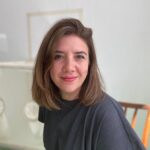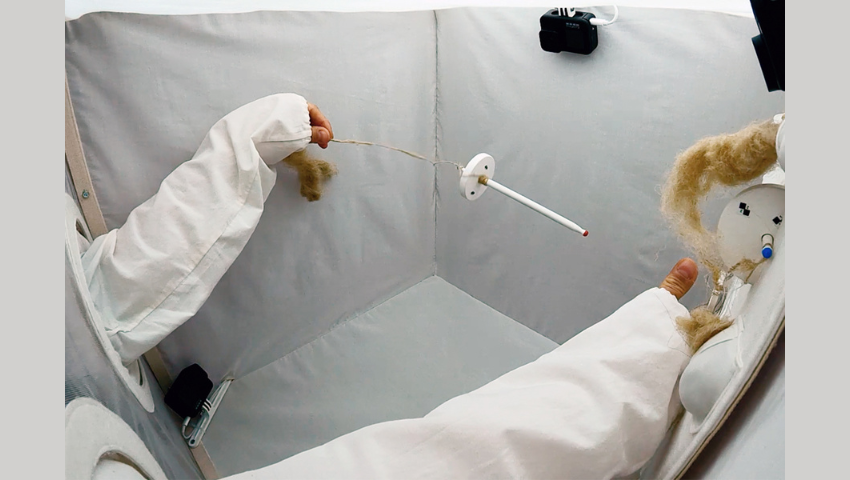Image Credit: Reinventing the Spindle, Ebru Kurbak. Supported by the LACMA Art + Technology Lab, the Austrian Science Fund (FWF): V-795, and the MIT Media Lab Space Exploration Initiative.
SIGGRAPH 2023 Art Gallery Best in Show winner, Ebru Kurbak, is weaving the cosmos and stitching the universe together in her award-winning project, “Reinventing the Spindle.” But what does it take to thread together such an innovative project? Ebru caught up with SIGGRAPH to talk about the inspiration that led to her journey in tackling the politics of near-space exploration along with questioning whose curiosity has been satisfied and whose knowledge has been marginalized.
SIGGRAPH: Tell us about the inspiration behind your SIGGRAPH 2023 Art Gallery project and Best in Show winner “Reinventing the Spindle.”
Ebru Kurbak (EK): In my practice, I often explore how our biases shape our perception of certain materials, knowledge, and skills. In this particular project, I was inspired by stumbling across the fact that flax (Linum usitatissimum) was one of the first plants attempted to be grown in space on Salyut 1 in 1971. As someone who had worked with hand-spinning flax, I began to imagine how this material could be worked with in weightlessness; however, I could not find any research documentation on working with fibers in microgravity, while many other material experiments such as welding, soldering, glass forming, and 3D printing have been attempted in space. This got me thinking about the politics of research in microgravity and led me to recreate this ‘missing’ experiment 50 years later. I decided to combine one of the oldest earthly technologies, the making of a string, with high-end technology that simulates weightlessness. I took raw fibers and a hand spindle on a parabolic flight and tried to make a thread in conditions that were completely foreign to me.
SIGGRAPH: Why did you decide to have your project tackle the politics of near-space exploration? What challenges did you face in its creation, and how did you overcome them?
EK: Around the time I started thinking about this project, NASA announced that they were opening up the ISS to private research ventures, suggesting that a satisfactory amount of scientific experiments had already been carried out. This made me examine these research projects, and as a result, I asked myself: whose curiosity has been satisfied and whose knowledge has been marginalized all these years? The colonization of space often seems to us to be a distant possibility, and we do not always take it seriously. But the colonization of low Earth orbit is a present reality. I see weightlessness as common and am bothered by the profit-driven first-come, first-served attitude to near space.
There were, of course, many challenges. However, I was fortunate to receive the LACMA Art + Technology Grant and to be supported by the MIT Space Exploration Initiative, who took me on their parabolic flight. First, it takes a lot for an outsider like me to get used to the idea of going on a parabolic flight. Planning the experiment was also not easy. I spent two years discussing with the team and technical advisors from the flight company. Although most open calls for research in space are intended to be “open to all,” the guidelines are often created with specific types of experiments in mind. So, I decided early on that this research would have a performative character, and as such, the process of negotiating the guidelines would become an essential part of the project. As a manifestation of this process, I hand-made a unique zero-gravity experimentation booth in which I conducted the experiments.
SIGGRAPH: This installation builds on the knowledge derived from women’s, indigenous, and nomadic cultures. What drew you to referencing these cultures in your project’s creation?
EK: The answer to this has a lot to do with my personal history. As a woman growing up in Turkey in the 1980s, it was almost a must for me to learn textile handicrafts. My family has nomadic roots going back several generations, bringing with it knowledge of alternative philosophies of relating to the material world. As an artist, I prefer and find it important to work from my situated position. Diversity cannot be achieved by simply inviting people from different backgrounds to work for the same agenda. We need the greatest possible variety of individual positions that have the power to shape research interests, values, and methods to overcome homogeneity.
SIGGRAPH: Congratulations on being awarded Best in Show at the 50th conference celebration! What does it mean to you to win this award at such a monumental event?
EK: Thank you so much! To receive this award, especially this year and for this work, is incredibly meaningful to me. Intentionally working with such marginal material in the field of art and technology requires a certain amount of risk-taking, not only on my part but also on the part of the funders, supporters, and peer reviewers. Being awarded Best in Show at SIGGRAPH 2023 made me feel that my sincere efforts to contribute to bringing more diversity to the scene have been recognized and that this desire is shared by one of the most important communities in the field. It gives me tremendous motivation to keep pushing the boundaries.
SIGGRAPH: What do you hope SIGGRAPH 2023 participants took away from your Art Gallery installation?
EK: My installation involved a three-dimensional video re-enactment of my experience of hand-spinning in microgravity. What I wanted to achieve with this project was to inspire the audience to take ownership of weightlessness. I hope my audience walked away with the question of what they would have done in weightlessness based on their own unique knowledge, skills, and interests.
SIGGRAPH: What advice would you give someone considering attending a SIGGRAPH conference for the first time?
EK: I would recommend that artists do everything they can to attend the event in person. I found this year, that SIGGRAPH is not only an excellent opportunity to show work but also an extremely valuable environment and time to receive feedback and reflect on your own work. In particular, I benefited immensely from one-on-one conversations with the art gallery jurors and the many inspiring artists I shared the stage with.
Transcend into the future of digital art! If your innovative artwork is pushing the boundaries of what is possible, submit it to the SIGGRAPH 2024 Art Gallery program before submissions close on 30 January.

Ebru Kurbak is an artist and researcher born in Izmir, Turkey, and based in Vienna, Austria. Her practice explores the entanglements between art, technology, culture, and politics, with a focus on uncovering hidden values and ideologies in science and technology research. Ebru currently is a Senior Research Fellow at the University of Applied Arts Vienna and runs the arts-based research project titled “The Museum of Lost Technology” (2020–2024) funded by the Austrian Science Fund. She previously was PI of the arts-based research project titled “Stitching Worlds” (2014–2018) and a Visiting Professor at the University of Applied Arts Vienna (2020–2022). She also taught at the Departments of Visual Communication Design and Photography and Video at the Istanbul Bilgi University (2003–2006) and the Department of Space and Design Strategies at the University of Art and Design Linz (2006–2014). Ebru carried out artistic residencies at La Gaîté Lyrique (FR), V2_Institute for Unstable Media (NL), LABoral Cultural Center (SP), and EYEBEAM (US), and has exhibited at international platforms including the MAK – Museum of Applied Arts Vienna (AT), Ars Electronica Festival (AT), ZKM (DE), SIGGRAPH Conferences (US), Microwave Festival (Hong Kong), Istanbul Design Biennial (TR), and Piksel Festival (NO), among others. Ebru was awarded the LACMA Art + Technology Grant by the Los Angeles County Museum of Arts in 2019.



